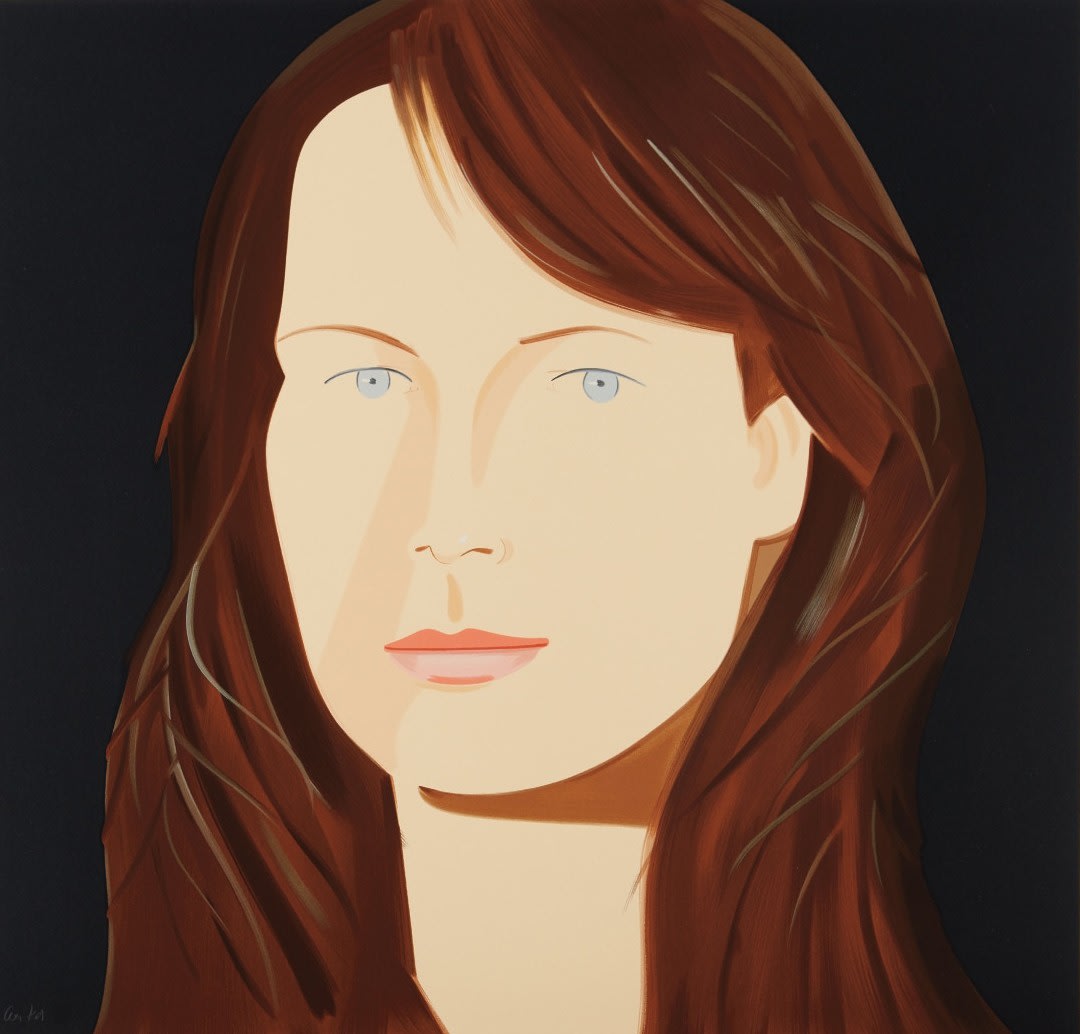Alex Katz
Alex Katz’s Sophie is among the most exacting and seductive achievements in the artist’s print practice, a tour-de-force screenprint that translates the lucidity of his painting into the language of layered ink. Completed in 2012 as part of a series of female portraits executed in screenprint, Sophie distills Katz’s lifelong project: to capture the sensation of seeing someone in real time, before narrative, before psychology, through a grammar of planes, edges, and calibrated color. The work’s technical ambition is inseparable from its aesthetic clarity. Katz deploys thirty-eight distinct colors—each demanding its own hand-pulled screen—to secure a surface that reads as effortless, even as it is the product of rigorous orchestration.
Visually, Sophie stages a face and figure edged against a field so refined it becomes light itself. Katz’s signature flattening, achieved here without the optical noise of visible brushwork, replaces modeling with adjacency: cheek to hair, lip to skin, skin to ground. The silhouette is decisive, almost cut with a blade; contours hold the composition with the poise of classical profile portraits while remaining unmistakably contemporary. Katz’s chromatic decisions, delicate passages of flesh tone set against assertive, graphic accents, sustain the image’s temperature. The colors do not blend; they lock together, building a presence that is crisp yet luminous. Every shape is spare but not minimal, economical but not austere. We feel the alertness of a glance, the charge of a pause, in the interval between two perfectly registered edges.
Thematic force arrives through restraint. Katz has long charted a middle path between figuration and abstraction, and Sophie is exemplary in how it treats likeness as a problem of structure rather than storytelling. There is no overt biography offered, no interiority made legible through expressionism; instead, identity emerges from rhythm—how a dark form of hair caps a lighter plane of forehead, how the mouth’s curve punctuates a field of skin, how the negative space around the head breaths like sky. In this sense, Katz extends the legacy of American modernism—Hopper’s clarity, Kelly’s edges, Stella’s rigor—into the social realm of portraiture, where a person becomes an architecture of looking.
Screenprinting is not merely a means here but the argument of the image. Thirty-eight screens articulate thirty-eight decisions: hue, value, opacity, and interval. The medium’s demand for absolute registration turns each junction into a hinge of meaning; a hairline misalignment would break the spell, while perfect fit yields Katz’s characteristic immediacy. Unlike painting, where a color can be revised into wet layers, screenprint commits in strata, one pass after another, so that the final surface carries time compacted into a single, unified present. Katz exploits this property to produce a print that feels at once engineered and weightless, its flatness acting as a conduit for light rather than a denial of it.
Within Katz’s broader portrait project—from the perennial figure of Ada to New York’s cultural milieu—Sophie underscores his interest in the contemporary icon. The subject is specific (a person with a name) yet archetypal (a face distilled to essentials). Katz’s cropping evokes cinema and advertising while remaining anti-spectacular; the scale of the head against the field reads as billboard-cool, but the touch is intimate, almost private. That duality, monumental and close, has defined Katz’s contribution to postwar art, and Sophie demonstrates how screenprint, with its clarity of edge and capacity for saturated color, can match the declarative energy of his best canvases.
It is also a statement about looking now. Katz eliminates anecdote in order to heighten attention, ours and his, to the event of encounter. In Sophie, precision yields tenderness: not sentimental feeling, but the tenderness of accuracy, the exactness by which one recognizes another. The print’s silence is eloquent. It lets light, edge, and color do the social work of portraiture—presence without story, intimacy without disclosure.
As a culmination within his screenprinted portraits, Sophie proves how far Katz can push the medium while keeping faith with his core values: clarity, speed of perception, and the dignity of surface. Thirty-eight colors sound like a technical boast until one sees how effortlessly they resolve into a single, breathing image. That resolution—complex means, simple ends—is the hallmark of Katz at his finest.
Provenance
The publisherPrivate collection, United States
Literature
Gunhild Bauer and Klaus Albrecht Schröder. Alex Katz. Prints 1947-2023. Catalogue Raisonné. Stuttgart: Hatje Cantz, 2023, cat. no. 503, pp. 296-297 (illustrated in color).




